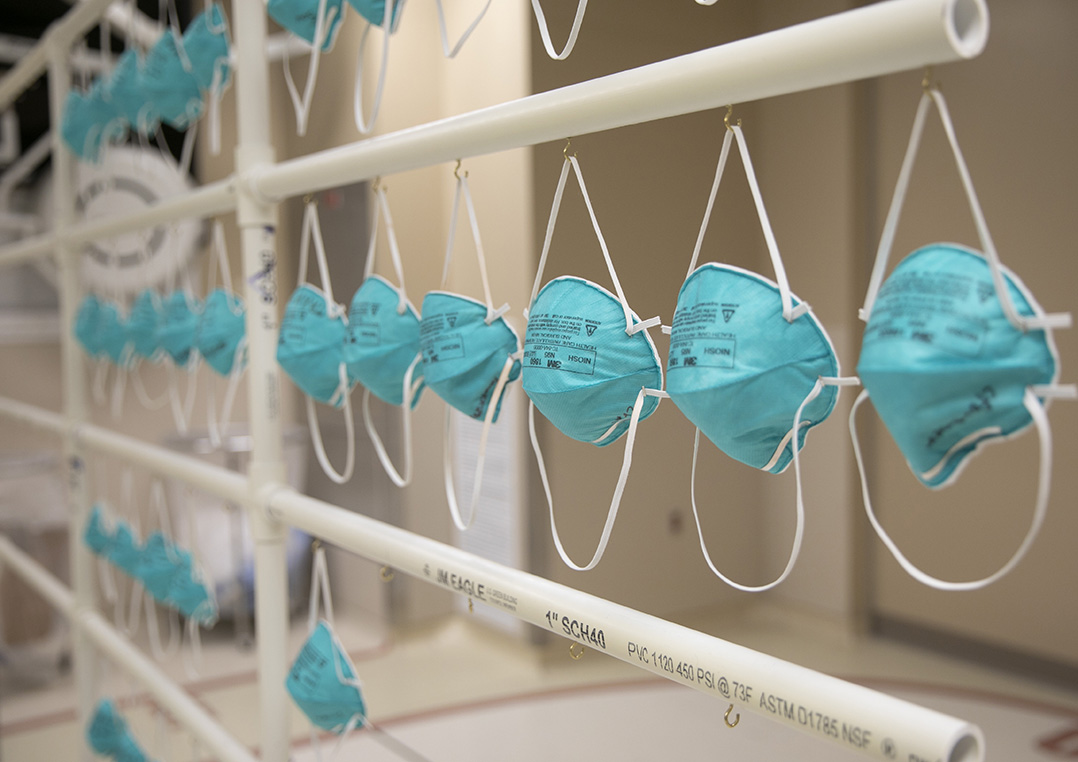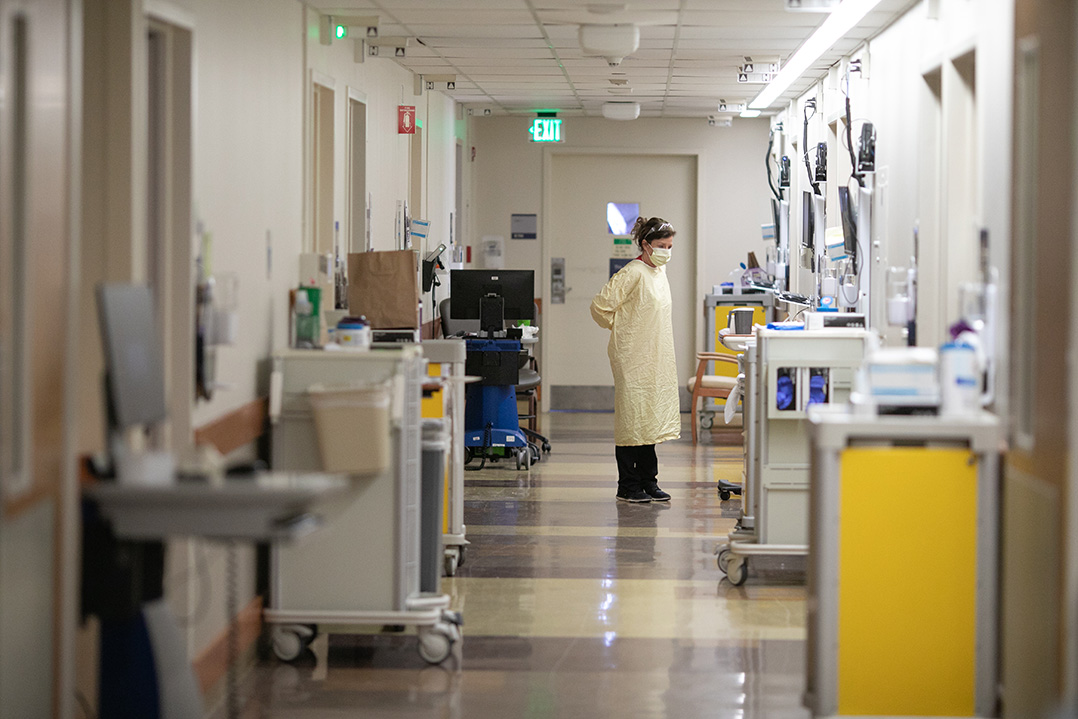Dr. Tracey Ikerd has spent the last several months helping patients at Ascension St. Vincent in Carmel battle a disease no one had heard of a year ago.
With COVID-19 not likely to end its worldwide rampage soon, doctors and researchers have scrambled to understand the new coronavirus and find a treatment or vaccine. Progress has been made, but for Ikerd, who specializes in infectious diseases, the biggest lesson learned so far is to be prepared for almost anything.
“I’m impressed with the severity of some of the patients contrasted with the extremely mild presentation of the others,” he said. “Some are minimally symptomatic, others come and have an inexorable disastrous decline and fall off the end of the earth and there’s very little you can do about it. There’s times I’ve felt helpless watching people deteriorate and pull every trick out of my pocket to keep them going, but other times people turn around almost on a dime.”
As the pandemic rages on, there’s still much to learn, but medical professionals have made great strides in understanding COVID-19 and developing treatment strategies since the disease arrived in Hamilton County in March.
It’s not like the flu
When COVID-19 first began making headlines in the U.S., it was often compared to the flu. Although both illnesses have similar symptoms, doctors have learned they aren’t as alike as once thought.
“We started off treating it a lot like a flu pneumonia, but it’s very different,” said Paul Calkins, chief medical officer at IU Health North hospital in Carmel. “Our first move was to put people on a ventilator, but it turns out you don’t necessarily have to do that. If you give people high-flow oxygen therapy and put them on their stomachs, you can oftentimes avoid ventilation, which is not something we knew early on.”
Doctors said they are grateful COVID-19 didn’t begin spreading rapidly in the U.S. until the flu season was nearing its end, because treating surges of both diseases at the same time would have put hospital beds and personal protective equipment in even shorter supply than they were when the pandemic began.
And that’s exactly why they’re stressing the importance of getting a flu vaccination this fall.
“We need you to not get influenza, because (concurrent surges of the flu and COVID-19) will potentially overwhelm hospitals and health systems,” said Michele Saysana, chief quality and safety officer at IU Health.

Slowing a supply shortage
It didn’t take long for health care systems locally and across the globe to learn that they were not well-prepared to handle a sudden, drastic increase in need for certain supplies, such as N95 face masks and gowns.
Eric Marcotte, chief medical officer at Riverview Health, said before the pandemic hit, Riverview typically kept three to four days’ worth of medical supplies in stock, which had never been a problem before. But suddenly, hospitals across the world needed large quantities of the same equipment at the same time, leading to global shortages and panic-filled moments.
Marcotte remembers testing swabs being nearly impossible to obtain early in the pandemic, which limited who could be tested for COVID-19 as it continued to spread.
“Who would’ve thought specialized Q-tips were the thing keeping me awake at night?” Marcotte said. “It was for about a week.”
Doctors from various hospitals in Hamilton County said they are no longer experiencing shortages. Learning who needed specialized equipment — such as those performing an intubation on a COVID-19 patient — helped ease the rush to secure personal protective equipment.
“We don’t have to have everyone in the entire building in the N95 respirator, which is helpful,” Marcotte said.
‘It’s important we’re allies’
Hospitals in Hamilton County and the region have been working together to manage through the pandemic. Even before COVID-19 hit, the six health systems in the Indianapolis area shared ideas and feedback through the Indianapolis Patient Safety Coalition.
“We don’t want to compete on safety,” Saysana said.
Early in the pandemic, the chief medical officers from each system met daily. Now, they do so approximately once a week. Saysana said that level of cooperation and open communication are key in battling COVID-19.
“That doesn’t happen in other places,” Saysana said. “It’s important we’re allies in this.”
Medical professionals have been stepping up to help colleagues within health care systems, too. At IU Health, doctors and nurses who saw their workload drop with the cancellation of elective procedures and appointments helped increase the care for patients in intensive care units and elsewhere.
Medical professionals also are providing support for each other as the pandemic drags on and takes a toll on their mental health.
“We’re making do,” Marcotte said. “Medical people are trained to deal with pretty terrible stuff, and most of us are pretty darn tough.”
What’s working
Although there’s still no cure or vaccine for COVID-19, doctors have begun using treatments that appear to help some of the sickest patients.
Marcotte said convalescent plasma, which is taken from the blood of a person who has recovered from COVID-19, seems to make the most difference, but it’s in short supply.
“That’s more valuable than gold right now,” he said. “Having the liquid part of the blood from someone that’s immune (to COVID-19) and having their antibodies to give someone that’s dying from it is miraculous.”
Those who have recovered from COVID-19 can learn more about plasma donation at versiti.org or redcrossblood.org.
Doctors also said they have seen positive results in some patients given remdesivir, an antiviral drug developed by Gilead Sciences to treat Ebola, although it wasn’t effective against that disease. The drug is in short supply, so it’s only given to the sickest patients.
Doctors also have learned that the new coronavirus can lead to blood clots in some patients, so they’ve started prescribing blood-thinning medications to COVID-19 patients admitted to the hospital.
“We think that’s gone a long way to improve people’s chances of survival,” Marcotte said.
Virtual appointments likely to stay
The pandemic-induced lockdowns led to several changes in doctor/patient interactions. Marcotte said he had done one telemedicine appointment before April. Now, it’s become part of his daily routine.
Saysana said she believes virtual appointments are here to stay.
“This showed us our patients like this, and our providers could feel out how to do it,” Saysana said. “We needed a little bit of that. It was a necessity for us to provide care that way, and now people are like, ‘I can do this.’”
It’s not as deadly as first thought
As doctors continue learning more about COVID-19, the odds of surviving it continue to rise.
“The chances of dying and the chances of having significant complications and problems in the hospital have been dropping pretty much every week,” Marcotte said. “It’s still worse than the flu, but it’s not 100 times worse than the flu that it looked like originally.”
In June, 6.2 percent of the COVID-19 cases reported in Indiana were fatal. That number dropped to 5.6 percent in May and 4.3 percent in June. Hamilton County saw 68 COVID-19 deaths in April, 21 in May and seven in June.
Although that may provide comfort for many people, doctors say it’s important to continue social distancing, wearing masks and making other efforts to keep the disease from spreading to those most vulnerable to COVID-19, including the elderly and those with a compromised immune system.
“They’re always at a risk for bad things happening to them,” Marcotte said. “Coronavirus is particularly good at finding those folks.”
Taking measures to prevent the spread of COVID-19 is especially important because of the often imperceptible nature of the disease.
“For every person out there that is symptomatic, there are five to six or nine or 10 who are minimally symptomatic,” Ikerd said. “That’s where the problem is. We cannot gauge a person looking at them and saying whether or not they have coronavirus with any certainty at all.”
At the same time, Ikerd is optimistic about the future.
“I’m feeling more confident we will get through this,” Ikerd said. “I’m confident we’re making progress with therapy and hopefully a vaccine. I feel like we will survive this, and we will come out the other side a little smarter.”



